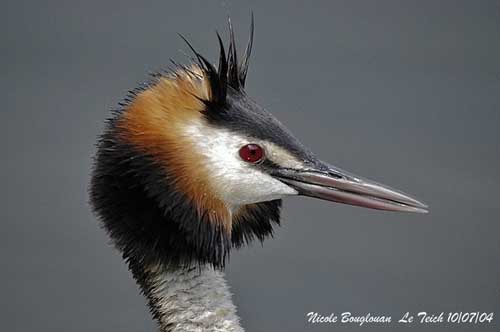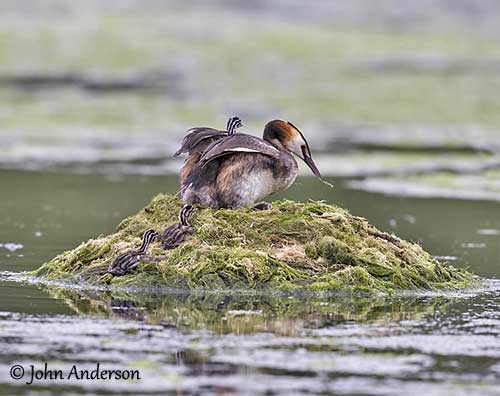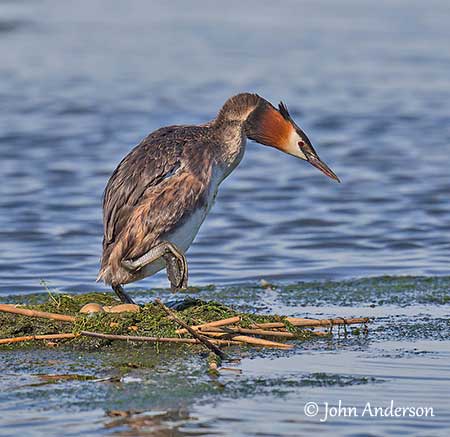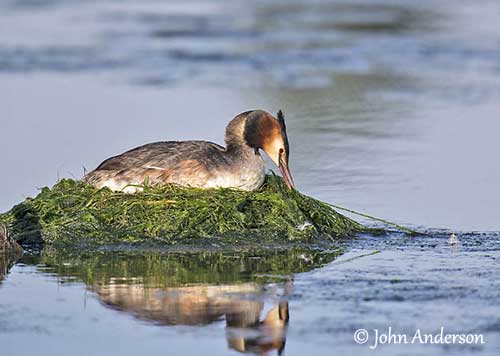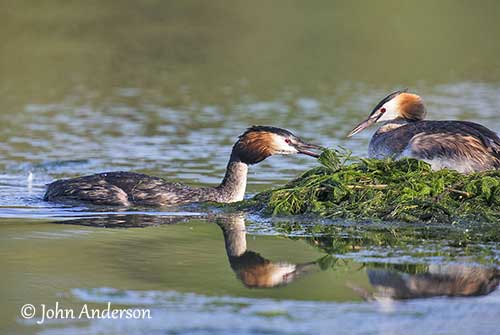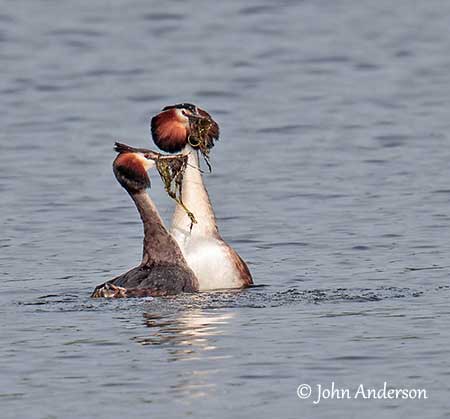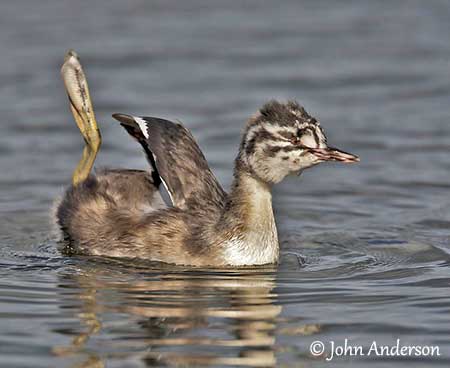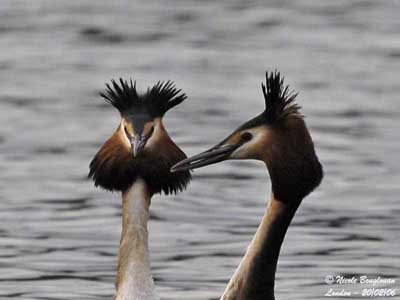
Fr: Grèbe huppé
All : Haubentaucher
Esp: Somormujo Lavanco
Ital: Svasso maggiore
Nd: Fuut
Sd: Skäggdopping
Port : Mergulhão-de-crista
Photographers:
John Anderson
John Anderson Photo Galleries
José Luís Beamonte
Pájaros de España
Steve Garvie
RAINBIRDER Photo galleries
Nicole Bouglouan
PHOTOGRAPHIC RAMBLE
Text by Nicole Bouglouan
Sources:
HANDBOOK OF THE BIRDS OF THE WORLD vol 1 by Josep del Hoyo-Andrew Elliot-Jordi Sargatal - Lynx Edicions - ISBN: 8487334105
THE HANDBOOK OF BIRD IDENTIFICATION FOR EUROPE AND THE WESTERN PALEARCTIC by Mark Beaman, Steve Madge - C.Helm - ISBN: 0713639601
THE COMPLETE BOOK OF BRITISH BIRDS – Written by “Royal Society for the Protection of Birds” experts - Préface de Magnus Magnusson - Michael Cady- Rob Hume Editors - ISBN: 0749509112
BirdLife International (BirdLife International)
Great-crested Grebe
Podiceps cristatus
Podicipediforme Order – Podicipedidae Family
BIOMETRICS:
Length: 46-61 cm
Wingspan: 59-73 cm
Weight: 800-1490 g
DESCRIPTION:
This so elegant aquatic bird performs spectacular courtship displays, a kind of “pas de deux” in the middle of a lake, with the reeds as witnesses and sometimes us, when we are lucky!

Both adults are similar.
In breeding plumage, adults have greyish-brown upperparts, including the very short tail. The upperwing shows black and white pattern. The hind neck is black.
On the underparts, neck, breast, belly and vent are whitish. Body sides and flanks are light reddish-brown. Underwing is white, as the short undertail feathers.
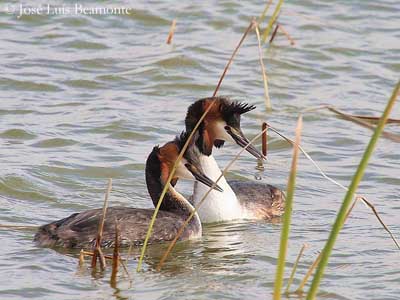
The head is very beautiful with spectacular black crest on the forecrown, and conspicuous ruff around the head, from the cheeks to the hind crown and the nape. This ruff is rufous-chestnut at base, and black-tipped.
Face is black and white with black forehead and forecrown, and white cheeks and ear-coverts. Lores are black, bordered above by white loral line.
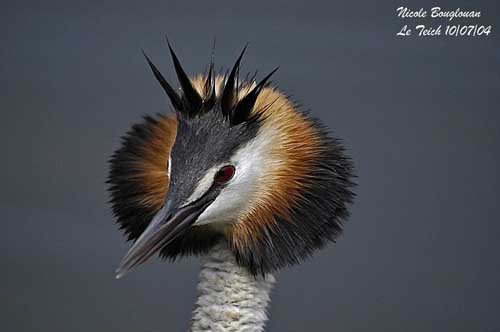
The bill is pinkish-grey, fairly long, straight and pointed. Eyes are deep red. The short legs are far on the lower belly, making the bird very clumsy on the ground. The lobed feet and the legs are blackish.
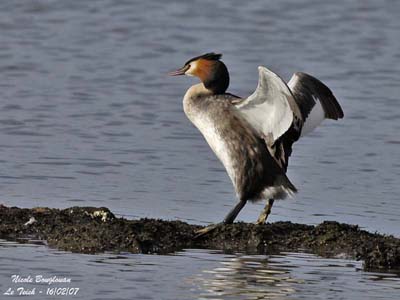
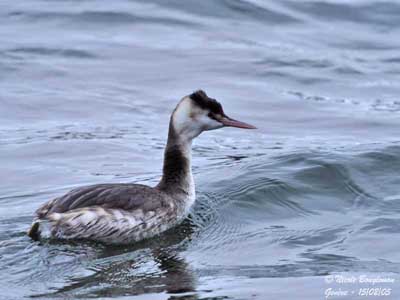
The Great-crested Grebe in winter plumage lacks the ruff and the head is only black and white. The body plumage is duller and greyer.
Juvenile has greyish-brown plumage and streaked black and white head. The young remains striped until it moults into winter plumage.
There are three subspecies:
P.c. cristatus – Palaearctic. In the southern parts of the range, populations winter in coastal regions.
P.c. infuscatus – Some populations in E, S and WC Africa. This race lacks the white loral line and the seasonal variations.
P.c. australis – SW and SE Australia and Tasmania. This one is similar to nominate race but maintains the breeding plumage all year round.
VOICE: SOUNDS BY XENO-CANTO
The Great-crested Grebe gives barking calls “rah-rah-rah”, also a clicking “kek” and a low growling “gorr”.
Chicks give loud whistles calls.
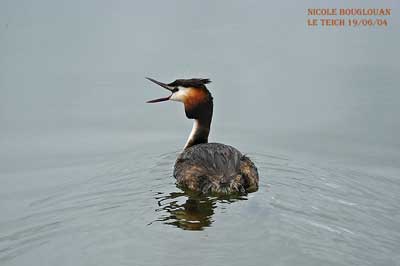
HABITAT:
The Great-crested Grebe breeds in fresh or brackish water bordered with vegetation, and some areas of open waters for foraging.
This species also frequents artificial water bodies and pools, or backwaters of slow-flowing rivers and gravel-pits.
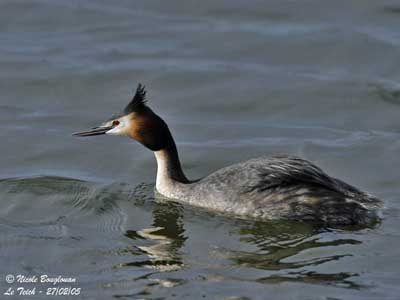
But in Tropical Africa, it can be seen on cold montane lakes up to 3000 metres of elevation and more, and in New Zealand, it frequents lakes up to 1000 metres.
The Palaearctic birds do not tolerate hard conditions such as occasionally partially frozen waters.
After the breeding season, we can observe dispersion to coasts, estuaries and large lakes and reservoirs.
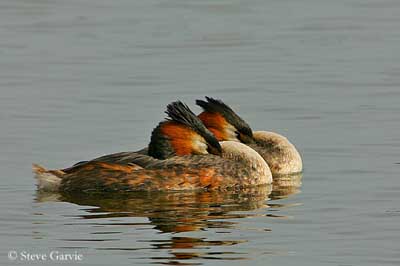
RANGE:
See above the range of the three subspecies.
Large groups congregate at inland reservoirs in winter, others move to coasts.
BEHAVIOUR:
The Great-crested Grebe feeds primarily on fish of variable sizes, and of several species. It also takes numerous insects and aquatic invertebrates, especially in spring, and amphibians’ adults and larvae.
It forages by diving, often pursuing the prey underwater. It may disappear during 18 to 25 seconds in areas of open water with some vegetation.
It also may feed from the surface by submerging only the head, or by picking insects from vegetation.
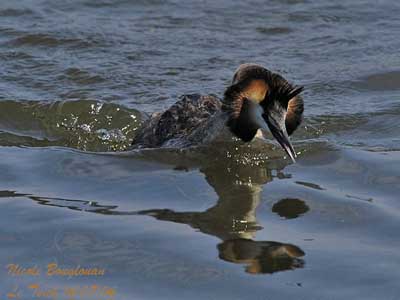
The Great-crested Grebes have spectacular courtship displays. Both mates are facing each other with raised head feathers, making the colours very conspicuous during the displays.
We can observe several phases. Actually, there are five series of ritual displays. They start with advertising calls by one of both mates.
Displays take place on the water, at least the first phases. The typical display is the “head-shaking ceremony” which is an introduction to other more spectacular. Both birds face each other with necks erect and they shake their heads up and down and from side to side. This display is silent.
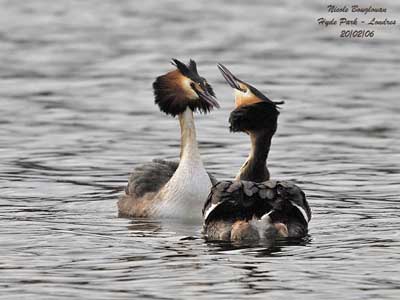
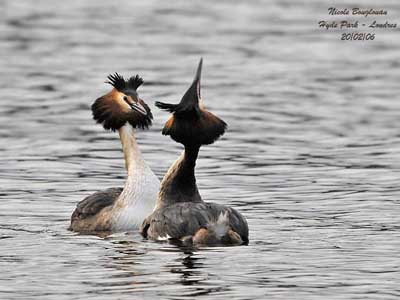
Then, both mates perform the “weed-ceremony” in which both swim away from each other and slowly submerge. After a few seconds, they reappear with the bill full of vegetation and they move towards to each other and rise up vertically with furiously paddling feet, breast to breast, and rocking their heads from side to side, producing a beautiful dance.
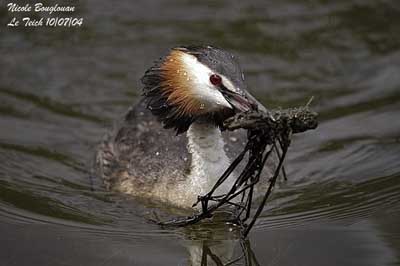
Copulation usually takes place on platform built in shallow water. The female goes up to the platform and invites the male by lying flat and uttering soft calls. The male jumps onto her back, copulation occurs quickly and the male returns to the water.
Then, both mates perform “head-shake” together.
These behaviours often start long time before the laying.

Although infrequent, direct attacks or threat displays between different grebes’ species or against other intruders have been observed.
But they spend most of the time foraging, resting and cleaning their plumage.
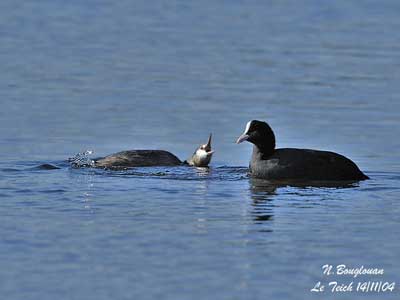
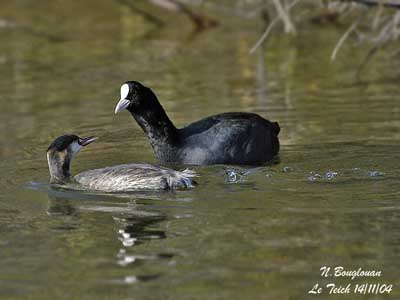
The Great-crested Grebe performs dispersions and migrations, mainly in the northern parts of the range. They perform some movements on large lakes and reservoirs to moult, but some of them moult in the breeding waters. After moulting, they move to coasts where they can be seen in large flocks.
There is no true migration in Africa where dispersions occur according to the rains.
In New Zealand, we can observe local post-breeding dispersions.
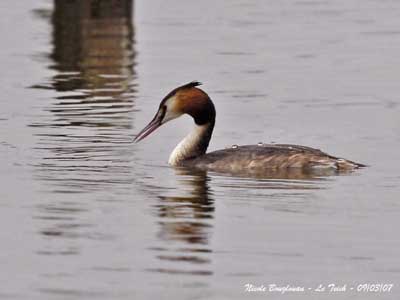
FLIGHT:
Usually, in the face of any danger, the Great-crested Grebe prefers to dive and swim rather than fly because it needs to run a long way along the water before to take off, while performing rapid wing-beats as it does in flight. This species performs up to six beats per second.
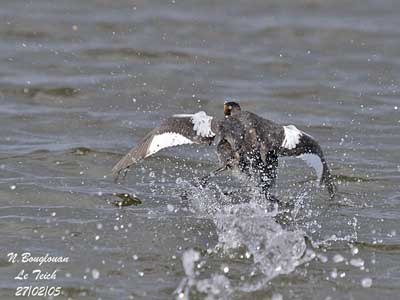
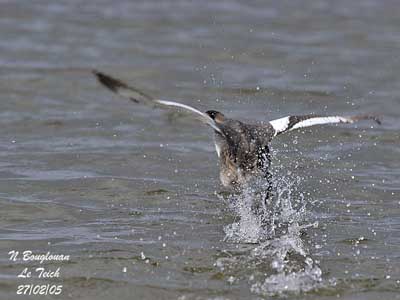
However, they are able to fly quickly and over long distances when they disperse or migrate. The flight allows us to see the beautiful black and white wing pattern.
REPRODUCTION:
Breeding season occurs mainly in April-June in Europe. In Africa, all months are used or after long rains. In Australasia, peak laying occurs between November and March.
The Great-crested Grebe usually nests solitary, dispersed or in loose colony. This species builds the nest in a platform of aquatic plants, usually floating and anchored to the vegetation or built from aquatic weeds of the bottom of the lake.
Female lays 3-5 eggs and produces one brood, sometimes two. Incubation lasts about 25 to 31 days. The eggs first are creamy-white, but when the female leaves the nest for feeding, she covers them with algae. Little by little, the eggs turn ochraceous to pale chestnut with the algae pigments.
The chicks are covered in striped black and white down. They are fed by both parents and fledge about 70 to 80 days after hatching. The family usually splits into two parts, each parent feeding one or two chicks.
We can see the young on adult’s back, often the female while the male brings them some fish.
They reach their sexual maturity at two years old, but some young birds can mate and establish territory, or even breed into the first year.
DIET:
The Great-crested Grebe feeds mainly on fish of various sizes and species, and even small eels. It also takes numerous insects’ species, aquatic invertebrates, crustaceans (crayfish and shrimps), molluscs (snails) and amphibians’ adults and larvae. It may consume some plant matter too.
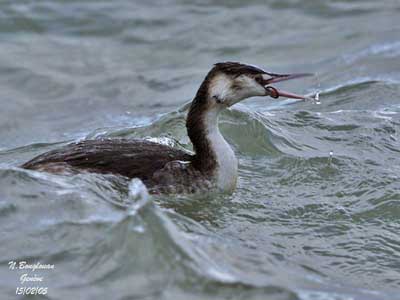
PROTECTION / THREATS / STATUS:
The Great-crested Grebe is widespread, but several declines were observed in Europe during the 19th century, due to hunting pressure for feather’s illegal trade. But populations seem to recover good numbers.
This species is able to adapt to man-made wetlands, producing increase of populations in several parts of the range.
The African race “infuscatus” is locally common. The Australasian race “australis” is uncommon but stable in Australia. Declines occurred in New Zealand with arrival of Europeans and the species is now threatened, unable to recover from effects of past persecution. But recent observations suggest some stability of the populations.
Currently, the Great-crested Grebe is not threatened.
